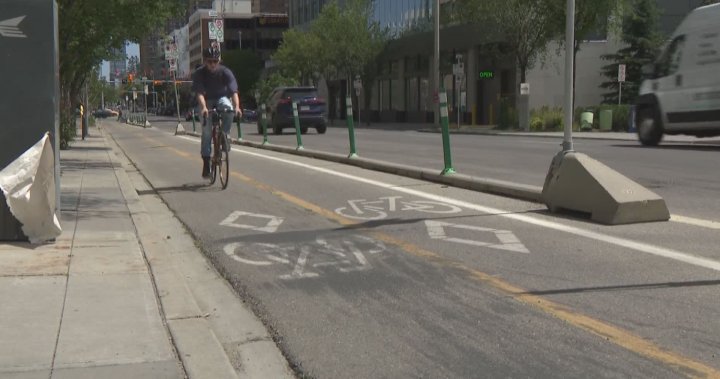In what seems like yet another escalation in provincial-municipal tensions, Calgary’s bike lane strategy has become the latest battleground between Mayor Jyoti Gondek and Alberta Transportation Minister Devin Dreeshen. The dispute ignited last week when Dreeshen took to social media to criticize Calgary’s approach to cycling infrastructure.
I’ve been watching this situation unfold from City Hall, where tensions over urban mobility have been simmering for months. What makes this particular clash noteworthy is how it reflects deeper philosophical divisions about city planning and transportation priorities.
Dreeshen’s comments came after a provincial review of municipal infrastructure spending, where he specifically targeted Calgary’s bike lanes as an example of wasteful spending. “Calgary continues to prioritize empty bike lanes over critical road maintenance,” the minister wrote on X (formerly Twitter), attaching photos of what appeared to be underutilized cycling paths.
Mayor Gondek wasted no time responding, defending the city’s comprehensive mobility strategy. “Our transportation planning is data-driven and responds to the needs of all Calgarians,” she stated during a press conference at City Hall. “The minister’s selective photographs don’t represent the full picture of our cycling network’s usage or benefits.”
What’s particularly interesting about this dispute is its timing. Calgary has recently reported a 15% increase in cycling commuters since 2019, according to the city’s latest mobility report. The pandemic seemingly accelerated changing transportation habits, with more residents seeking alternatives to public transit and personal vehicles.
The conflict highlights a fundamental difference in vision. The province, led by Premier Danielle Smith’s UCP government, has consistently prioritized vehicle infrastructure and expansion of roadways. Meanwhile, Calgary’s council has been pushing toward a more multi-modal approach that includes cycling, walking, and public transit alongside traditional vehicle infrastructure.
City Councillor Gian-Carlo Carra, a long-time advocate for alternative transportation, told me during a recent interview that the dispute goes beyond bike lanes. “This is about who gets to decide how Calgary grows. Is it local representatives who understand neighborhood needs, or provincial officials with their own priorities?“
The economic dimensions of this argument shouldn’t be overlooked either. Calgary’s own economic development strategy emphasizes quality of life factors, including transportation options, as crucial for attracting younger workers and innovative companies. Several tech startups that recently chose Calgary over other Canadian cities cited the city’s improving urban mobility as a factor in their decision.
“We located downtown specifically because our employees can commute safely by bike or transit,” explained Sarah Martinez, CEO of SolarTech Solutions, a renewable energy company that moved to Calgary last year. “It’s a recruitment advantage for us.”
The cycling network has seen substantial growth over the past decade, with the 2015 installation of the downtown cycle track network marking a significant milestone. Despite initial controversy, usage data has shown steady increases, particularly during Calgary’s warmer months.
But provincial criticism goes beyond just questioning usage. Dreeshen suggested the money would be better spent addressing Calgary’s pothole problem, which he called “among the worst in the province.” City officials counter that transportation funding comes from different budgetary streams, and that the cycling network represents less than 3% of the overall transportation budget.
The dispute has caught the attention of urban planning experts across the country. “What we’re seeing in Calgary reflects a broader tension in growing Canadian cities,” noted Dr. Patricia Reynolds, urban planning professor at the University of Calgary. “There’s increasing evidence that diverse mobility options provide economic and social benefits, but political divisions often form along traditional car-centric versus multi-modal lines.”
For everyday Calgarians, the political posturing sometimes obscures the practical realities. Stephen Wong, who commutes by bike from Kensington to his downtown office, expressed frustration with the debate. “I use these lanes every day, even in winter. They’re not empty. But my colleagues who drive also deserve good roads. Why does it have to be one or the other?“
The cycling community has mobilized in response to the minister’s comments. Bike Calgary, a local advocacy organization, issued a statement inviting Dreeshen to join them for a guided tour of the cycling network during peak hours. “We welcome the minister to experience firsthand how these investments are serving thousands of Calgarians daily,” their statement read.
As Calgary continues to grow and evolve, these tensions between provincial and municipal visions will likely persist. What remains to be seen is whether practical compromises can emerge from the political rhetoric, or if transportation planning will remain caught in the crossfire of larger intergovernmental disputes.
For now, Calgarians continue to navigate the city as best they can—some on two wheels, others on four—while their elected officials battle over the roads they travel.







